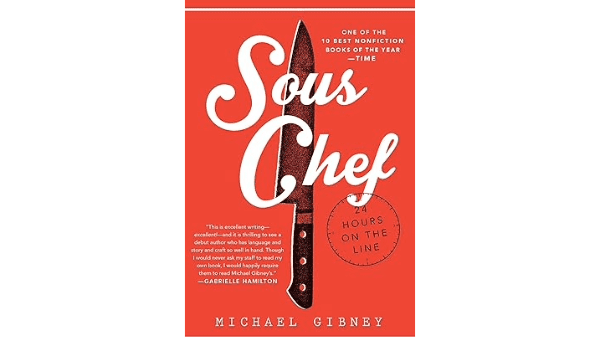This month, my wife’s book group is reading Michael Gibney’s Sous Chef, an account of 24 hours of the author’s life as a sous chef (that is, underchef) in a prestigious New York restaurant. Time called it one of the best nonfiction books of the year, and after reading it myself, I can see why.
Gibney’s book underscores the tense dichotomy in the restaurant trade: merciless hours and tough conditions, along with a devotion that for many workers means that they’ll never do anything else.

I paid particular attention to the parts dealing with fresh produce. Early morning inspection:
“In the case of produce, everything should be properly kitted up in plastic containers. Fresh lettuce glows green in Lexans, gold bar squash shines in Cambros. Every container should be easily visible and clearly labeled with its contents, the packing date, and the initials of the handler. If the produce has not been properly organized in a ‘first in, first out’ fashion, you should be able to identify the issue immediately and correct it without difficulty.”
Gibney’s organizational flow chart (top: executive chef; bottom: dishwashers) is puzzling at first. There is a poissonnier (you learn a lot of French in this business) for fish, a rôtisseur for meat, but who handles the vegetables? It turns out that that’s the job of the entremetiers (again, one for fish, one for meat): “they are responsible for the ‘middle work,’ which can be very intense.” For every steak broiled or fish seared, the “respective entremet prepares anywhere from two to twelve garnishes—vegetables, starches, sauces, salads, etcetera. . . .
“This can be a special challenge in a restaurant where everything is prepared to order—à la minute. Your average entremet is accustomed to managing fifteen or twenty separate pans of food at once. As a result, usually only the most motivated cooks can work the entremetier station. They are typically young, exuberant cooks with a few years of experience, in the early stages of their development.”
In fact, the specter of imminent burnout hangs over just about everyone on board, not excluding the man at the top.
Still, the specials are all about protein: terrine of boudin blanc and squab confit; charred herring; veal tongue agnolotti; pork loin sous vide. (Fortunately, there is a glossary at the end of the book.) The biggest challenge for the author—whose specialty is fish—is monkfish roulade (roll) with foie gras. Monkfish is devilishly hard to skin, and it requires a real professional to trim all the veins from the foie gras.
The book probably reflects a setting around 2011 (the chef still uses a BlackBerry), so I wonder what might have changed in a restaurant like this today. They’d probably have a vegetarian option (winter squash ravioli, say, but that would be an easy out) and maybe a vegan option too. But I suspect that protein in whatever form would still have the starring role.
I admire every last person who handles this grueling routine on a more or less seven-day basis, with no vacations. But as I said to my wife, “There is not one word in this book that leads me to think I would like this work or be any good at it.”



